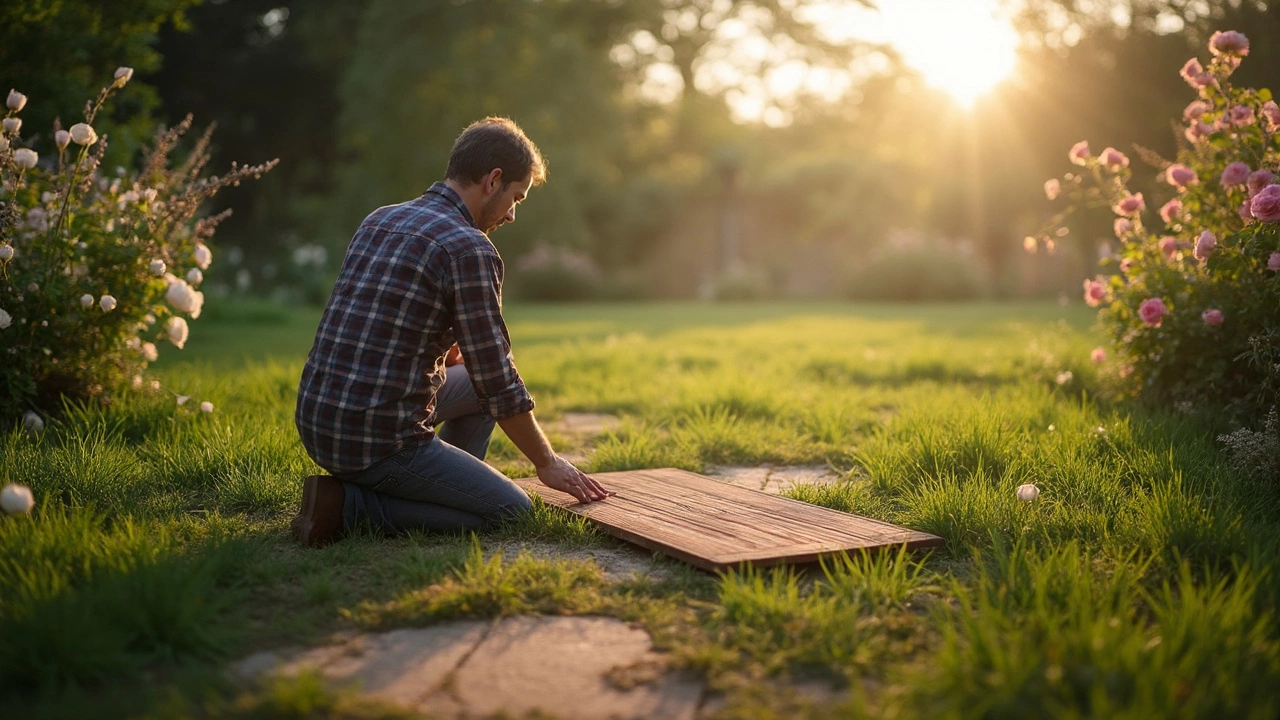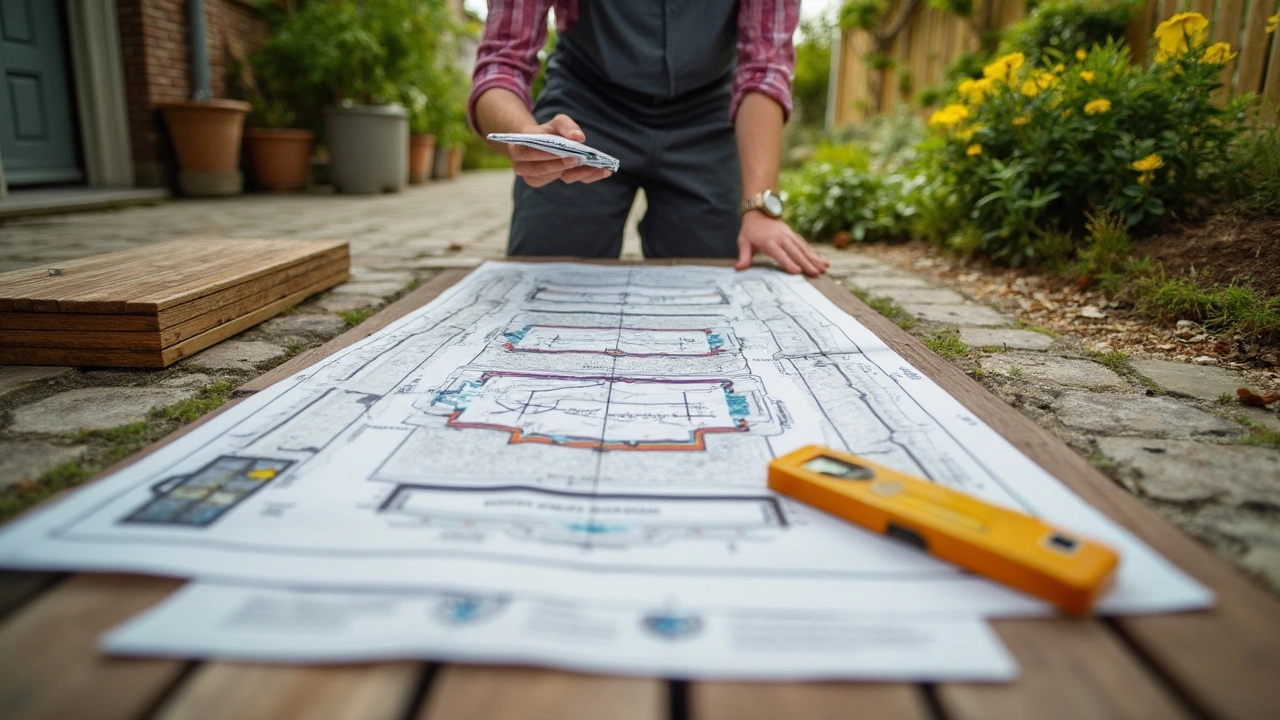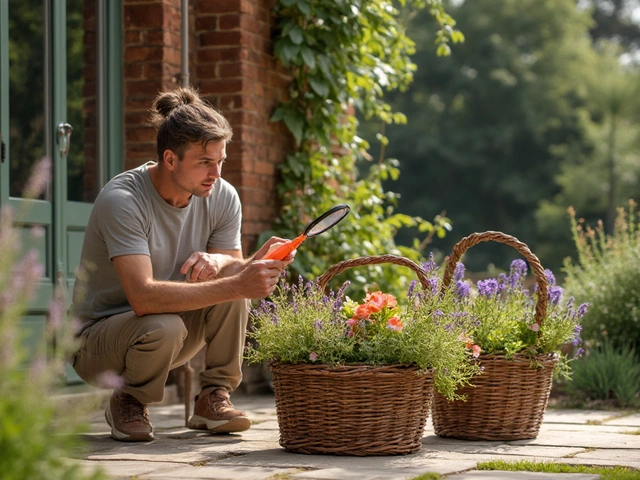 24
Mar,2025
24
Mar,2025
So, you're looking at that lush lawn of yours and thinking, wouldn’t it be great to lay down some decking tiles for a chic garden vibe? I get it, the idea is tempting. Just plop those tiles down and voilà, you’ve got an instant lounging zone. But before you go wild with the plan, there’s a bit of homework involved if you want lasting results.
First off, decking tiles directly on grass isn't usually the best route. Without a solid base, things can get uneven pretty fast. You might find your tiles sinking or shifting, especially after heavy rain or if the ground isn't as stable as it looks.
But wait, all hope isn’t lost. With some prep work, you can still achieve that dream outdoor space. Starting with a level and firm surface is key, maybe by installing a solid base like gravel or sand. This doesn't just hold tiles in place but also allows for proper drainage, preventing water from pooling around and under your new deck tiles.
- Why Consider Decking Tiles on Grass?
- Challenges of Installing Directly on Grass
- Smart Preparation Tips
- Choosing the Right Decking Tiles
- DIY vs. Professional Installation
- Maintenance Tips for Outdoor Decking
Why Consider Decking Tiles on Grass?
Decking tiles on grass might seem odd at first, but there are solid reasons why people choose this option. Right off the bat, it's an easy way to create an inviting outdoor space without committing to a permanent structure. Otherwise dull sections of lawn can gain personality almost overnight. And for renters or those indecisive about a design, decking tiles offer a non-permanent solution that can easily be removed or relocated.
Decking tiles can deliver the same sleek, modern look as traditional decks but without the hefty price tag. Plus, there’s no need for a specialist to swoop in, which means you save on installation costs. It’s a sweet setup for anyone balling on a budget yet still wanting to boost their outdoor game.
Another great thing about using these tiles is versatility. They come in various materials like wood, composite, or even stone-look finishes. Choosing the right decking tiles based on your style preference and how much foot traffic you expect can make all the difference.
Eco-Friendly Options
For the nature lovers out there, some decking tiles are made from recycled materials, making them an earth-friendly choice. It’s a win-win situation: beautify your garden space and do your part for the environment.
On top of all that, decking tiles installed over grass can improve drainage in your garden. Unlike a solid deck, the spaces between tiles let water seep through, reducing the risk of waterlogging in areas prone to heavy downpours.
There you have it, a combination of flexibility, economic benefits, and eco-friendly choices make decking tiles on grass an appealing option for many homeowners. If done right, they offer a seamless transition from the indoors to your backyard oasis.
Challenges of Installing Directly on Grass
Thinking about laying decking tiles straight onto your lawn? Well, that’s not a walk in the park. There’s some stuff you need to know before you go all in. Sure, it sounds like a simple plan, but there are a few hiccups you might hit along the way.
Uneven Surface
Grass might look flat and inviting, but its surface usually isn't uniform. This can lead to uneven tiles, which not only looks bad but can also be a trip hazard. Imagine stepping out for a morning coffee only to trip over a rogue tile. Not fun.
Stability Issues
Let's talk about stability. Simply put, grass isn’t a solid foundation. Without support, the ground beneath will shift and settle over time, especially if the tiles are exposed to changes in weather like rain. Your tiles might start sinking like those old chairs on a too-soft carpet.
Mold and Moisture
Grass retains moisture. So, placing tiles directly on it means inviting mold and mildew, particularly underneath where it stays damp and dark. It doesn’t take much for a wet environment to become a breeding ground for unwanted growth.
Poor Drainage
Drainage is another biggie. Laying tiles straight on grass can block water flow, leading to puddles that can damage not just your outdoor flooring but also the grass underneath. Nobody enjoys that squishy feeling underfoot.
It’s these challenges that often have people rethinking the direct-to-grass approach. Solving these issues usually involves a tad more preparation, like using a base layer of gravel or sand beneath the tiles. This simple step can set up your deck to be solid and durable.
Smart Preparation Tips
Alright, you're ready to get serious about laying those decking tiles on grass. Here’s how to lay the groundwork, literally, for a durable and stylish garden floor.
Get the Ground Ready
Start by mowing the grass short wherever you want the tiles. This makes it easier to spot uneven spots and gives tiles a better surface to rest on. Remove any rocks or debris to avoid any bumps under your tiles.
Add a Base Layer
You need a solid base, and gravel is your best friend here. Spread a good 2-4 inch layer of gravel on the mowed grass area. This base should be even and compact. It helps with drainage—which is crucial to prevent water pooling and tile shifting.
Lay Sand for Stability
On top of the gravel, a layer of sand works wonders for leveling. A good inch or two should do it. Spread it out evenly, checking the level as you go. This sand base gives extra stability to your outdoor flooring.
Now Set the Tiles
Finally, it's tile time. Lay your decking tiles on top, starting from one corner and working your way out. Use spacers if you want uniform gaps for that clean, professional look. Press them into the sand gently but firmly to set them in place.
Final Checks
Step back and check for level alignment one last time. Adjust any tiles if needed before you call it a day. Your preparation work should now serve as a sturdy stage for your outdoor hangout space.
So, with these steps, you’re set to lay down those decking tiles for a space that looks good and stands the test of time.

Choosing the Right Decking Tiles
Picking the perfect decking tiles for your garden isn't rocket science, but there are several key factors you should keep in mind. Quality matters here, especially since these tiles face the elements. You want durability, style, and usability all rolled into one.
Material Matters
When it comes to materials, you generally have a couple of options. Wood, composite, and plastic are some of the usual suspects. Wood decking tiles offer a natural look that’s hard to beat, but they might need more TLC and maintenance over time to avoid rotting or warping.
Composite tiles are a mix of wood fibers and plastic, giving you the best of both worlds. They tend to be more resistant to weather and don’t require as much elbow grease. Finally, plastic tiles are budget-friendly and often designed for easy installation with snap-together features, though they might not have the same authentic look as wood or composite.
Size and Design
The size of your decking tiles can make a big difference too. Larger tiles are faster to install and can make small spaces feel bigger. Meanwhile, smaller tiles allow for intricate designs and patterns. Don't forget to think about how they’ll fit with the rest of your garden design—consistency in style is key.
Weather Considerations
Another thing to keep an eye on is your climate. If you’re in a region with heavy rainfall or extreme temperatures, you might want tiles with enhanced drainage features or weatherproof properties. Some of the best decking tiles come with built-in grooves to ensure water doesn’t pool on their surface, reducing slip hazards.
Eco-Friendly Choices
If you're environmentally conscious, consider eco-friendly options. Many manufacturers offer tiles made from recycled materials. Not only do they bring unique style but also reduce your carbon footprint.
| Material | Durability | Maintenance |
|---|---|---|
| Wood | Moderate | High |
| Composite | High | Low |
| Plastic | Moderate | Low |
Ultimately, the right decking tiles for your outdoor space come down to what works best with your environment, your style preferences, and the amount of maintenance you're willing to do. Research, plan, and you’ll make the best choice for a beautiful, functional outdoor area.
DIY vs. Professional Installation
When it comes to deciding between a DIY approach and hiring a professional for laying decking tiles, there are a few things to consider. It’s all about weighing your skills, time, and budget. So, which path suits you best?
Doing It Yourself: The Budget-Friendly Path
If you're handy around the house and love a creative project, DIYing might be right up your alley. Not only is it cost-effective, but it also gives you the freedom to personalize your methods. To begin, you’ll need some basic tools: a tape measure, level, rubber mallet, and a saw, if some tiles need trimming.
With DIY, every step is in your hands—from preparing the site to placing each tile just so. For smaller areas, this could be a satisfying weekend project. But remember the prep work we mentioned? Skipping it could lead to a wonky setup.
- Pros: Cost-effective, customizable, and plenty of personal satisfaction.
- Cons: Time-consuming, requires a good amount of sweat equity, and results rely on your hands-on skills.
Bringing in the Pros: Efficiency and Expertise
On the other hand, if you're not feeling particularly crafty or lack the time, hiring professionals is tempting. They come with experience, the right tools, and an eye for detail. The project might be completed faster than you'd think, with a cleaner, more finished look.
Plus, professionals are adept at tackling any surprises your lawn might throw their way. Uneven surfaces or tricky drainage issues are no match for seasoned installers. You'll likely end up with a robust setup, especially for larger surfaces.
- Pros: Quick and clean results, less stress, and no need to lift heavy tiles yourself.
- Cons: More expensive and less room for impromptu changes.
Crunching the Numbers
| Option | Cost | Time |
|---|---|---|
| DIY | Low ($$) | High (Hours to Days) |
| Professional | High ($$$) | Low (Hours) |
Ultimately, the method you choose comes down to personal priorities. Are you up for a hands-on experience with potential hiccups, or is a smooth, polished process more your style? Whatever you choose, stepping onto that fresh deck with a sense of pride is what really matters.
Maintenance Tips for Outdoor Decking
Maintaining your brand new decking tiles isn’t just about sweeping up fallen leaves – there's a bit more to it, especially if you want them to last and stay looking sharp. Here’s how you can keep your outdoor space in tip-top shape.
Regular Cleaning
Dust, dirt, and debris can quickly build up on your decking tiles, so a routine clean-up is essential. Use a soft-bristle broom or a leaf blower to sweep away surface debris every week. For a deeper clean, grab a garden hose and give it a good wash, or bust out the power washer for stubborn grime.
Check for Damages
Mother Nature can be tough. Cracks, splits, or any sign of wear and tear can sneak up on you. Regularly inspect the tiles for damage and replace any that's too far gone. Catching a small problem early can save you from having to replace entire sections later on.
Pay Attention to the Weather
In areas prone to heavy rain or harsh sunlight, be proactive. Consider applying a UV-protective sealant to protect against sun damage. When rain’s a big player, ensure good drainage around and beneath your decking – you don't want your outdoor flooring floating away with the next storm.
Maintain the Surroundings
- Trim overgrown plants and grass around the deck area. This prevents leaves from accumulating and stops unnecessary moisture build-up.
- Avoid using harsh chemicals or salt in areas close to your decking tiles, as they can degrade both the tiles and nearby plant life.
Annual Deep Dive
Once a year, treat your decking tiles to a comprehensive inspection and clean. Remove every tile and check for water damage or insect infestation on the base. Give them a good scrub, and reapply any sealants to keep them strong and looking fresh.




